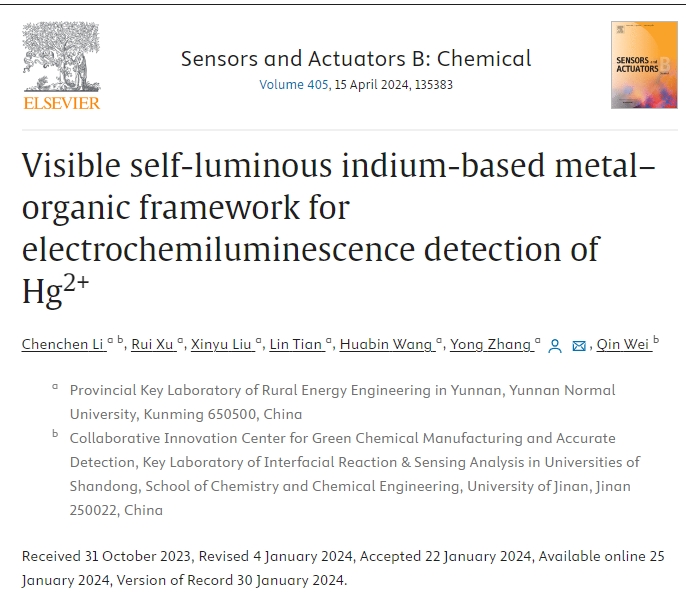博文
云师大能环学院张勇课题组在国际top期刊《Sensors and Actuators B: Chemical》发表
||
2024年1月25日,Elsevier 旗下国际著名期刊《Sensors and Actuators B: Chemical》在线发表了云南师范大学能源与环境科学学院张勇教授课题组的最新研究成果《Visible self-luminous indium-based metal–organic framework for electrochemiluminescence detection of Hg2+》。云南师范大学能源与环境科学学院张勇教授为通讯作者。合作单位为济南大学魏琴教授课题组。 Abstract
Abstract
Herein, we report a self-luminous metal–organic framework (MOF) with a three-dimensional (3D) cubic structure (i.e., RuIn-MOF) prepared by coordinating tris(4,4′-dicarboxylicacid-2,2′-bipyridyl)ruthenium(II) dichloride (i.e. Ru(dcbpy)32+) with InCl3. RuIn-MOF exhibits excellent electrochemiluminescence (ECL) performance and emits red light that is visible to the naked eye. The 3D self-luminous RuIn-MOF not only exists stably in the aqueous environment, but also uses Ru(dcbpy)32+ as its organic ligand to effectively increase the loading of chromophores, which effectively improves the luminescence efficiency. RuIn-MOF possesses a large specific surface area and abundant pore, and its porous structure can enrich the co-reactants, which further improves the luminescence efficiency. Notably, the UV–vis absorption spectra of NiFe-based nanocube and the AuNPs overlap with the ECL emission spectrum of RuIn-MOF; the ECL signal is doubly quenched through resonance energy transfer (RET), which significantly improves sensitivity. Accordingly, we prepared a double-quenching ECL sensor based on the RET strategy with RuIn-MOF as the ECL signal probe, which captures Hg2+ through specific thymine-Hg2+-thymine-type (T-Hg2+-T) interactions and relies on NiFe-based nanocube@Au as the quenching agent. The developed sensing strategy rapidly and efficiently detects Hg2+ in the 10−14 to 10−5 mol L−1 range, with a limit of detection of 2.19 × 10−16 mol L−1.
https://www.sciencedirect.com/science/article/pii/S0925400524001126
扩展阅读:
https://blog.sciencenet.cn/blog-454141-1420290.html
上一篇:云师大能环学院李建昌教授在《Applied Energy》期刊发表最新研究成果
下一篇:云师大生命科学学院、马铃薯科学研究院尚轶教授在TOP期刊《Food Chemistry》发表最新成果